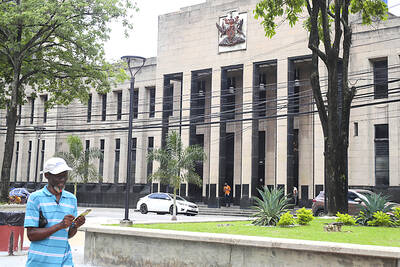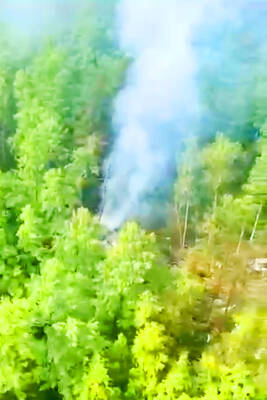A Greenpeace ship found the Japanese whaling fleet off Antarctica yesterday, the environmental group said -- setting off this year's round of a cat-and-mouse contest that has become a sometimes dangerous feature of the hunting debate.
Greenpeace's Esperanza confronted the whalers in the Antarctic Ocean early yesterday after a 10-day search and the hunting ships immediately steamed off with the activists in pursuit, the environmentalists said in a statement.
They warned they would take non-violent action to try to stop the ships from killing whales -- a promise that in the past has led to activists in speedboats trying to put themselves between whales and Japanese harpoons, once leading to a collision of ships.
Japanese whaling officials were not immediately available to confirm Greenpeace's claims or provide details.
In November, Japan dispatched its whaling fleet to the icy waters of Antarctica to kill about 1,000 whales under a program that Tokyo says is for scientific purposes, a claim anti-whaling nations and activists scoff at as a joke.
Under worldwide pressure, Japan last month abandoned its plan to include 50 humpback whales in this season's hunt, which would have been the first major hunt of humpback whales since the 1960s. But it still plans to kill 935 Minke whales and 50 fin whales.
Greenpeace and the anti-whaling group Sea Shepherd sent ships after the whalers to try to prevent the hunt by harassing the Japanese vessels. Their first task was to find the Japanese ships, the next to keep up with them.
In previous years, the whalers have been able to avoid the environmentalists for weeks and sometimes to evade them with their faster ships. In 2006, Greenpeace ship Arctic Sunrise collided with a Japanese whaler during a tense standoff over whales, causing minor damage but no injuries.
Karli Thomas, a Greenpeace spokeswoman aboard Esperanza, said the ship spotted six Japanese whalers early yesterday.
"The first thing they did when we approached them was to scatter and run," Thomas said. "We stayed with the factory ship the Nisshin Maru, which is always the major target."
Australia urged both sides not to do anything dangerous.
"The people actually at the site, on the high seas, need to be very careful," Assistant Treasurer Chris Bowen told reporters in Sydney. "They need to exercise restraint because their own personal safety is at risk and the personal safety of others is at risk."
Australia for the first time this season sent a government-hired ship to collect photo and video evidence for a possible legal challenge to Japan's whaling program.

Trinidad and Tobago declared a new state of emergency on Friday after authorities accused a criminal network operating in prisons across the country of plotting to kill key government officials and attack public institutions. It is the second state of emergency to be declared in the twin-island republic in a matter of months. In December last year, authorities took similar action, citing concerns about gang violence. That state of emergency lasted until mid-April. Police said that smuggled cellphones enabled those involved in the plot to exchange encrypted messages. Months of intelligence gathering led investigators to believe the targets included senior police officers,

FOREST SITE: A rescue helicopter spotted the burning fuselage of the plane in a forested area, with rescue personnel saying they saw no evidence of survivors A passenger plane carrying nearly 50 people crashed yesterday in a remote spot in Russia’s far eastern region of Amur, with no immediate signs of survivors, authorities said. The aircraft, a twin-propeller Antonov-24 operated by Angara Airlines, was headed to the town of Tynda from the city of Blagoveshchensk when it disappeared from radar at about 1pm. A rescue helicopter later spotted the burning fuselage of the plane on a forested mountain slope about 16km from Tynda. Videos published by Russian investigators showed what appeared to be columns of smoke billowing from the wreckage of the plane in a dense, forested area. Rescuers in

A disillusioned Japanese electorate feeling the economic pinch goes to the polls today, as a right-wing party promoting a “Japanese first” agenda gains popularity, with fears over foreigners becoming a major election issue. Birthed on YouTube during the COVID-19 pandemic, spreading conspiracy theories about vaccinations and a cabal of global elites, the Sanseito Party has widened its appeal ahead of today’s upper house vote — railing against immigration and dragging rhetoric that was once confined to Japan’s political fringes into the mainstream. Polls show the party might only secure 10 to 15 of the 125 seats up for grabs, but it is

Philippine President Ferdinand Marcos Jr is to meet US President Donald Trump this week, hoping Manila’s status as a key Asian ally would secure a more favorable trade deal before the deadline on Friday next week. Marcos would be the first Southeast Asian leader to meet Trump in his second term. Trump has already struck trade deals with two of Manila’s regional partners, Vietnam and Indonesia, driving tough bargains in trade talks even with close allies that Washington needs to keep onside in its strategic rivalry with China. “I expect our discussions to focus on security and defense, of course, but also